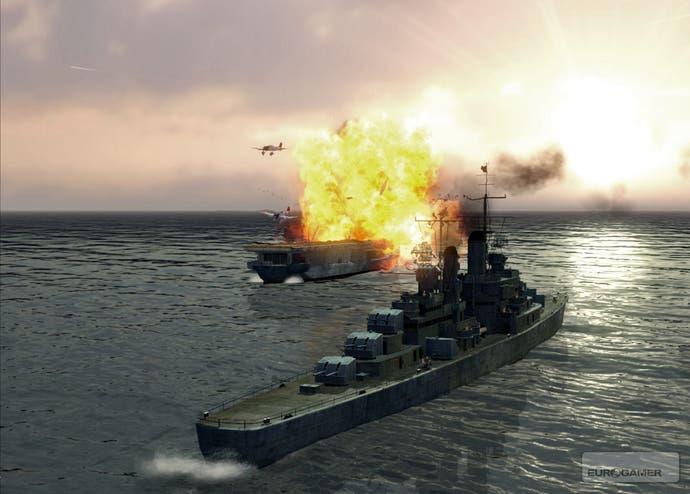Battlestations: Pacific
Ship-shape and Bristol fashion.
In terms of actual gameplay changes, the new ability to capture islands, rather than just pummel gun emplacements on them, is a key improvement. Bunkers and airfields can be targeted and shelled from your ships and then landing craft launched as you watch dozens of potential Private Ryan saviours struggle up the beach. You can then support them with aircraft or try to upend enemy jeeps as they beetle about tantalisingly within reach of your ship's guns.
Apart from the obvious benefit of killing the enemy, capturing an island usually also confers more specific bonuses, such as giving you access to a fog of war penetrating radio station or new airfields or boat-houses from which to launch extra units. This apparently is particularly important in multiplayer.
The tactical map screen has also been in dry docks for a refitting, with the new ability to stack orders and set waypoints. That may not sound as exciting as getting to rip battleships in half with 15-inch shells but it should drastically change the scope of tactical control in the game, where the original limited you to only one command at a time for each unit.
But never mind all that. Once all the sage nodding at the excitingness of the new map features was over it, was time to raise the Eurogamer ensign and give the Japanese what for in one of the American mission. As such we started off in an anti-aircraft gun aboard a large battleship, defending against kamikaze fighters (apparently you do get to fly as a kamikaze pilot yourself in the Japanese missions - as well as use the even more macabre Ohka manned-missile).

Again the graphics work superbly, not just in terms of detail but in cinematic flair as explosions rake across aircraft carrier decks and half-destroyed aircraft plummet into the sea. Things got even better once we took to the air in a missile-equipped plane, blowing up boat-houses before an all-out attack on a Japanese battleship. Although the flight model is hardly a simulation there is a new padlock and cockpit view which certainly adds to the sense of visual realism if nothing else.
At this point the new concept of secondary objectives was explained to us. These have been instigated not only as something to do while you wait for slow-moving ships to get into positions but also as a means to unlock special abilities such as increased power, repair speed or damage. Since you can switch between controlling any unit on the map at any time this means there need never be a dull moment, no matter how quiet the tactical map looks.

It's also around this time, as we took the controls of a torpedo plane and dodged the horribly dangerous-looking flak from a support vessel, that it began to dawn just how evocative the game is of the apparently never-to-be-continued X-Wing and TIE Fighter series. Our success with the battleship was attributable to a love of the old PC games, as we took a circular route to our quarry and despite our Eidos handler's increasing assertion that we didn't know what we were doing handily popped a few torpedoes up its poop deck (all viewed via a very attractive missile cam) and ended up being congratulated as the only jounro that day to achieve the feat.
It's not purely for that reason we came away from the game feeling upbeat though. Battlestations: Pacific changes or invents little that is revolutionary over the original, but it does seem to make an effort to address and avoid almost all the complaints. "We're happy to give them what they want," Mr Eidos person says on the subject of fans' wish-lists. And it seems almost certain they'll be happy to receive them.
Battlestations: Pacific is due out on PC and 360 somewhere between January and March 2009.
